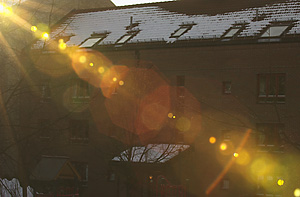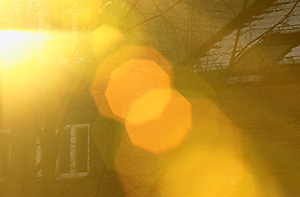| The Long March Towards
Revolution: AFS 70-200 mm f/2.8 G ED IF VR Nikkor
Reviewed |
|
|
| by Bjørn
Rørslett |
|
6.
Flare and ghosting
A zoom lens with 21 elements would, despite
sophisticated multi-coating treatment, be prone to unwanted
internal reflections. The 70-200 VR tries its very best to live
up to or rather exceed expectations in this area.
As shown by the test pictures (below),
grazing light striking across the front element give rise to huge
amounts of ghosting. A long row of hot spots march across the
image. Strong flare lowers image contrast to wash out details
especially towards the long end of the zoom range.
The poor performance exhibited by the
70-200 VR lens came as a surprise and underpins my suspicion that
flare control is not a primary parameter for contemporary lens
designs. I like to add that the glass surfaces of my review
sample were in a pristine shape without even the tiniest speck of
dust on them and of course the big sunshade was used all the
time, but evidently to no avail. Direct backlighting is a major
problem area for this zoom lens.
Amazing
Grace - grazing light hits the lens
|

|

|
| 70 mm f/22 At least 15 hot-spot ghosts (from each lens
group?) together with a plethora of larger secondary
ghosts make an ugly impression.
|
200 mm f/22 Huge amounts of flare add to the prominent
ghost reflections of the aperture, and effectively
destroys image content
|
When however direct light is kept off
the front of the lens, flare was under better control and
ghosting occurred less frequently. Every user has to decide
whether or not this issue is of concern for the intended
applications of the 70-200. Some people may be severely troubled,
while others manage to get off by less devastating results. I
guess it all depends on the way you tend to shoot your
assignments.
A question often asked is whether flare and
ghosting depend on the aperture setting. The answer to this is
that flare tends to diminish when the lens is stopped down, while
ghosting becomes more predominant visually. However, at the
minimum aperture used in the test above, the image area impacted
by ghosting should be as small as possible. At wider apertures
the ghosts themselves may be less apparent and simply add to the
generel level of flare.
Zoom lenses have always been susceptible to
excessive ghosting, often combined with a moderate resistance to
flare as well. Still, there is food for thought that even my
venerable old-timer 50-300 mm f/4.5 ED Nikkor manages
significantly better than the 70-200 VR.
| The Long March Towards
Revolution: AFS 70-200 mm f/2.8 G ED IF VR Nikkor
Reviewed |
|

